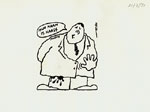Koos Koster in El Salvador
March 17, 1982: the fatal event
The Dutch televison crew from IKON, consisting of Koos Koster, Jan Kuiper, Joop Willemse, and Hans ter Laag, was in El Salvador to cover the situation in that country with regard to the coming elections of the Constituent Assembly of 28 March. The country had been in a state of civil war since 1979, and considerable areas were controlled by the FMLN. The FMNL had decided not to take part in the elections, which had become a competition between right and ultra-right groups.
Koster was no stranger to the situation in El Salvador, for in 1980, he had already made a documentary on the death squads in that country. On 7 March 1982 the reporters started interviewing imprisoned guerrillas in the Mariona prison. The prisoners openly thanked the team for their support in the struggle against the regime. In the days after 7 March Koos Koster contacted an FMLN agent to arrange a visit to a part of El Salvador that had been liberated by the guerillas. Later the authorities read note found on the body of one of the dead fighters. This note contained the name and address of Koos Koster in San Salvador. On 11 March Koster was brought in by police in civilian dress and interrogated by Colonel Morán. Koster was warned by Morán that there there were military forces searching for him. On 12 March an article and photos were published in the local press about the Dutch journalists with the explicit accusation that they were supporters of the 'subversivos'. In spite of these events the reporters decided to continue their work. The German journalist Armin Wertz was willing to drive them to meet people from the FMLN. Moreover, the reporters' hotel rooms appear to have been searched the night before they went north. Nevertheless on Wednesday, 17 March, the minibus with Wertz driving, the four Dutch journalists, and the two FMLN contacts, headed for Chalatenango. The driver noticed that they were being followed by a Cherokee Chief cross-country vehicle, a car often used by security agencies in El Salvador. The party continued heading north for about 65 kilometers, to the road to Santa Rita. They took that road for about 1 kilometer to a place where four armed men of the FMNL waited for them. Wertz arranged to meet them again on Sunday, 21 March, at 8 a.m., and immediately left for San Salvador. The remaining members of the group then left the road at about 5 p.m., and took a small trail that led into the country. After approximately 100 meters the group was fired upon. Two journalists were killed instantly. The FMNL fighters returned fire. In the firefight, all the journalists and three of the FMNL fighters were killed. Only the fighter named Martin escaped alive.
Inquiries in El Salvador and the Netherlands following this incident concentrated on whether or not the Salvadorian army knew where the group was headed and deliberately staged an ambush with the intention of killing the journalists. The Salvadorian army issued contradictory reports about whether they knew where the journalists were headed. Sergeant Mario Canizales Espinoza, commander of the patrol involved, stated that only vague reports had been received, saying that guerilla units possibly used this route for supplying nearby base camps. But officers of the El Paraíso barracks in the vicinity of the shooting declared that high officers planned the attack the day before, guided by specific information on the expected route of the reporters.
The inquiry of the Dutch government (May 28, 1982) concluded that neither intent nor coincidence could be proved. The inquiry did confirm that 'the journalists were killed by fire from small arms aimed from a distance'.
The Truth Commission of the United States Institute of Peace concluded in its report that (our paraphrase): 1) The journalists were killed in an ambush deliberately staged on the basis of intelligence data alerting the army to the journalists' presence, 2) Army officials covered up the truth and obstructed the investigations, 3) These murders violated international human right law, 4) The State failed in its obligation to investigate, bring to trial and punish the guilty parties, 5) The president of the Supreme Court failed to cooperate with the Commission on the Truth.
See also the report by the Truth Commission.

